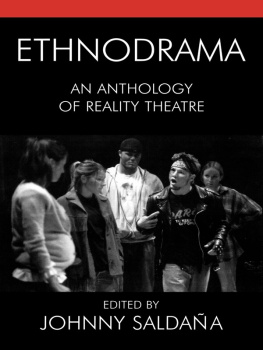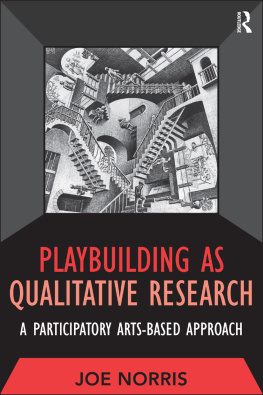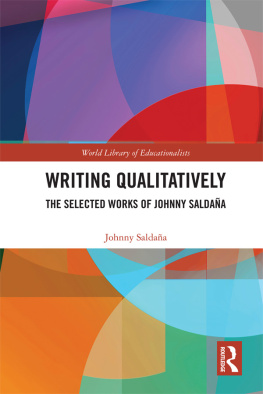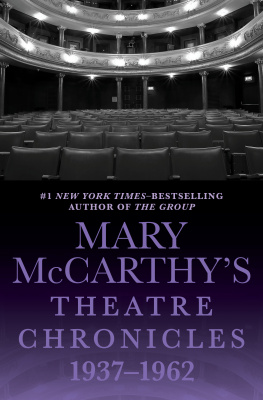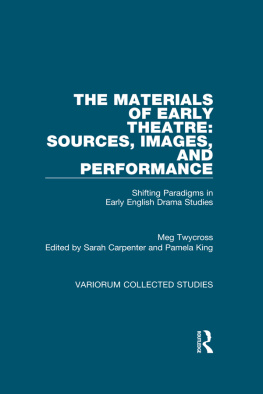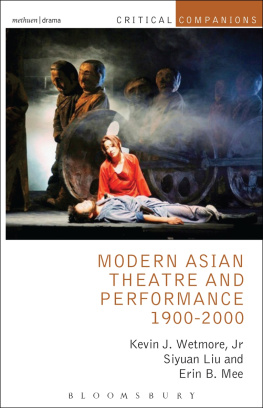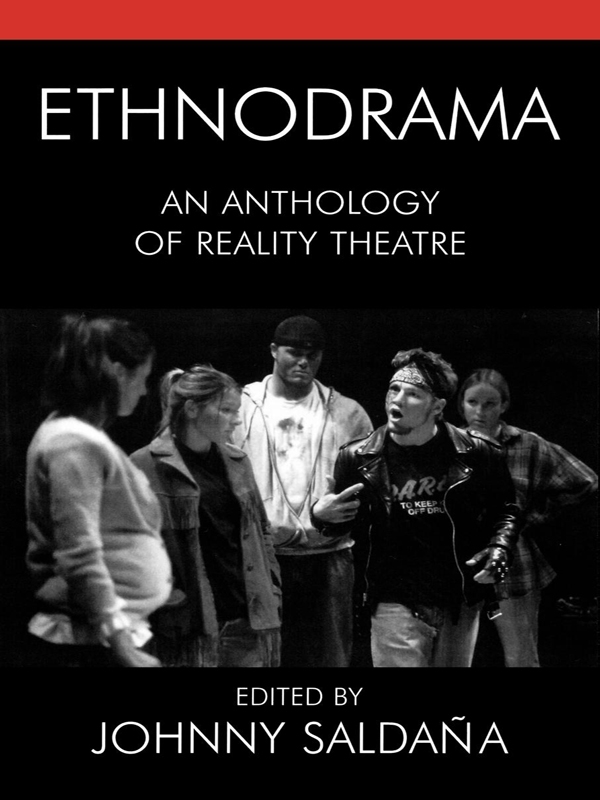Acknowledgments
Thanks are extended to the following:
Norman K. Denzin, Yvonna S. Lincoln, Mitch Allen, and AltaMira Press for supporting this publication project and acknowledging the legitimacy of arts-based research.
Kristina Razmara, Terry Fischer, Monica Riley, and the production staffs of Rowman & Littlefield and AltaMira Press.
The Arizona State University Katherine K. Herberger College of Fine Arts (J. Robert Wills, Dean), Institute for Studies in the Arts, and Department of Theatre; the University of Albertas International Institute for Qualitative Methodology; the University of Victoria Department of Theatre; the International Drama in Education Research Institute; and the American Educational Research Associations Arts-Based Educational Research Special Interest Group, for financially supporting the editors ethnotheatrical productions.
Brian Schlemmer, Harry E Wolcott, Charles Vanover, Susan Finley, and Macklin Finley, for allowing the editor to adapt their stories and research into ethnodramatic form.
Selected material from the editors introduction originally appeared in Johnny Saldaas Dramatizing Data: A Primer, Qualitative Inquiry, volume 9, number 2, 2003, pp. 21836, copyright 2003 Sage Publications.
Selections from Finding My Place: The Brad Trilogy originally appeared in Harry F. Wolcotts Sneaky Kid and Its Aftermath: Ethics and Intimacy in Fieldwork (AltaMira Press, 2002).
Elissa Fosters Storm Tracking: Scenes of Marital Disintegration originally appeared in Qualitative Inquiry, volume 8, number 6, 2002, pp. 80419, copyright 2002 Sage Publications; used by permission of the author.
The Practice copyright 2003 by Matthew J. Meyer; used by permission of the author. The play script also appears in Theatre as Representation (TAR) in the Teaching of Teacher and Administrator Preparation Programs in the International Electronic journal for Leadership in Learning (IEJLL), volume 8, number 6, 2004, www.ucalgary.ca/~iejll ; used by permission of the IEJLL editor, Kent Donlevy.
the theatre copyright 2001 by Monica Prendergast; used by permission of the author.
Scenes from Voices in the Rain copyright 1996 by Michael Keck; used by permission of the author.
Scenes from copyright 2003 by Jos Casas; used by permission of the author.
Chalkboard Concerto: Growing Up as a Teacher in the Chicago Public Schools copyright 2003 by Charles Vanover and Johnny Saldaa; used by permission of the authors.
Wearing the Secret Out copyright 2004 by Jennifer Chapman, Anne Swedberg, and Heather Sykes; used by permission of the authors.
Baddies, Grubs & the Nitty-Gritty copyright 1998 by Jim Mienczakowski and Steve Morgan; used by permission of the authors.
Street Rat copyright 2004 by Johnny Saldaa, Susan Finley, and Macklin Finley; used by permission of the authors.
Hidden copyright 2003 by Michael Rohd and Laura Eason; used by permission of the authors and Sojourn Theatre of Portland, Oregon.
Production rights for all ethnodramas in this anthology are managed by their respective authors. Contact information for inquiries can be found in About the Contributors.
Appendix
DRAMATIC MODELS FOR ETHNODRAMA
P laywriting instructors also assign play reading to study exemplars of the art and craft. Aside from ethnodramas, literary and commercial play scripts serve as models and stimuli for developing original performance ethnography. I recommend the following titles from dramatic literature but advise that you stay away from their film adaptations. The playwrights original conception and structure of the script may have been altered for the media.
For autoethnography models, read:
- Jo Bonney, ed., Extreme Exposure: An Anthology of Solo Performance Texts from the Twentieth Century (New York: Theatre Communications Group, 2000)
- Carolyn Gage, The Last Reading of Charlotte Cushman , in Lynn C. Miller, Jacqueline Taylor, and M. Heather Carver, eds., Voices Made Flesh: Performing Womens Autobiography (Madison, WI: University of Wisconsin Press, 2003)
- Holly Hughes and David Roman, eds., O Solo Homo: The New Queer Performance (New York: Grove Press, 1998)
- John Leguizamo with David Bar Katz, Freak: A Semi-Demi-Quasi-Pseudo Autobiography (New York: Riverhead Books, 1997)
- Jane Martin, Talking With ... (New York: Samuel French, 1983)
- Jane Wagner, The Search for Signs of Intelligent Life in the Universe (New York: Harper & Row, 1986)
For models that examine a principal investigators relationship with participants, read:
- Mark Medoff, Children of a Lesser God (Clifton, NJ: James T. White & Co., 1980)
- John Pielmeier, Agnes of God (Garden City, NY: Doubleday, 1982)
- Peter Shaffer, Equus (New York: Avon Books, 1974)
For models that incorporate participant interviews into monologue and dialogue, read:
- Michael Bennett, et al., A Chorus Line: The Book of the Musical (New York: Applause Books, 1995)
- Jessica Blank and Erik Jensen, The Exonerated (New York: Faber and Faber, 2004)
- Eve Ensler, The Vagina Monologues (New York: Dramatists Play Service, 2000)
- William H. Hoffman, As Is (New York: Vintage Books, 1985)
- Moiss Kaufman and Members of the Tectonic Theater Project, The Laramie Project (New York: Vintage Books, 2001)
- Anne Nelson, The Guys (New York: Random House, 2002)
- Anna Deavere Smith, Fires in the Mirror (New York: Doubleday, 1993) and Twilight: Los Angeles , 1992 (New York: Doubleday, 1994)
- Studs Terkels Working , adapted by Stephen Schwartz and Nina Faso (New York: Music Theatre International, 1978)
- Doug Wright, I Am My Own Wife (New York: Faber and Faber, 2004)
For a model that displays ways of presenting correspondence data, read
- A. R. Gurney, Love Letters (New York: Dramatists Play Service, 1989)
For models that include a narrator as a key figure, read:
- Thornton Wilder, Our Town (New York: Harper, 1960)
- Tennessee Williams, The Glass Menagerie (New York: Dramatists Play Service, 1976)
Playwriting texts recommended by colleagues who practice and teach the art form include:
- Lajos Egri, The Art of Dramatic Writing (New York: Touchstone Books, 1972)
- Michael Wright, Playwriting in Process: Thinking and Working Theatrically (Portsmouth, NH: Heinemann, 1997)
Bibliography
Ajwang, R. O., and L. Edmondson. (2003). Love in the time of dissertations: An ethnographic tale. Qualitative Inquiry 9(3), 46680.
Alexander, B. K. (2000). Skin flint (or, the garbage mans kid): A generative autobiographical performance based on Tami Sprys Tattoo Stories. Text and Performance Quarterly 20(1), 97114.
Armijo, L. M., and K. Lindemann. (2002). People of the shadows: An ethnographic performance exploring boundary management among the homeless. Unpublished manuscript.
Bagley, C., and M. B. Cancienne, eds. (2002). Dancing the data. New York: Peter Lang Publishing.

